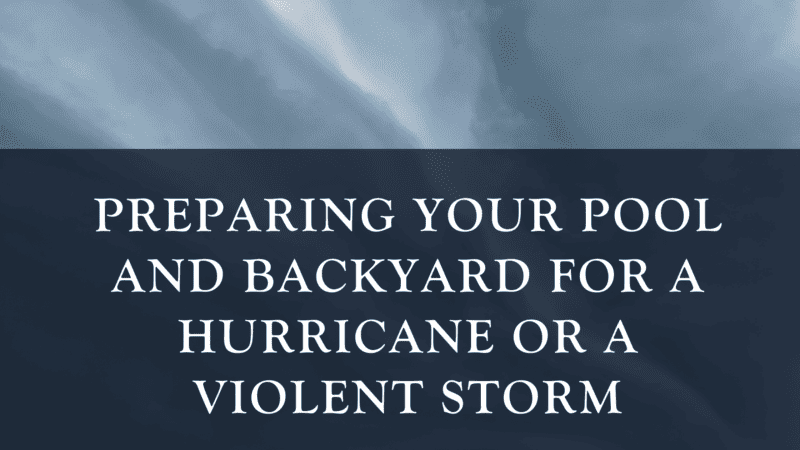Preparing Your Pool and Backyard for a Hurricane or a Violent Storm

Hurricane season is always of considerable concern. And some of you could be reeling from the pool and yard damage that Hurricane Teddy caused last year. Here’s the thing, whenever the government issues a hurricane watch, people tend to stock up on food, water, and gas. Don’t get me wrong; your safety and health come first. However, you ought to protect your property as this will save you from high repair and replacement costs. Not to worry, in this post, we’ve listed the key steps to follow as you prepare your pool for a hurricane/big storm.
1. Prune Your Backyard Tree Branches
Unless it is storm’s day, it would help if you pruned shrubs and the tree branches before the extreme weather event. Focus on the plants close to your house and pool since these could probably cause extensive damage. Bring any standalone plants and pots inside, as well as birdfeeders, patio heaters and anything made of glass.
2. Do Not Empty Your Swimming Pool
Contrary to popular belief, draining your swimming pool is possibly the worst thing you could do. Most people believe that draining prevents overflow and your backyard from flooding. Surprisingly, this rarely happens unless your pool’s overflow feature is not working. Pool water helps keep your vinyl-lined pool in position.
During a major storm, the water table increases, and if the pool is empty, your pool will detach or “float.” Remember, if your pool’s skimmers aren’t working, you could reduce the water by 2 feet.
3. Switch Off All Pool Equipment
It would be best to power off the circuit breaker attached to all pool equipment. If you plan on covering any of the equipment, wait until they cool off.
4. Do Not Cover Your Pool
Typically, it is advisable to use a pool cover to prevent dirt and chemicals from contaminating your pool water. However, in this case, your pool cover would be inefficient. There’s a high chance of it flying off or tearing due to debris and impact from other objects. Be sure to tie the cover to the roller and the roller to the fence. You may keep your auto cover closed and remove the cover pump from the deck. If you think there is a chance you will lose power or the amount of rainfall is significant you may not be able to remove the water quickly enough to prevent damage. In this case, leave the autocover open.
Now that you’ve detached your pool cover, it’s time to balance the pool’s water chemistry as an added safety measure. Test the water before adding any chemicals. The ideal alkalinity should be between 120 – 150, pH should fall anywhere between 7.4 and 7.6 and the calcium hardness at an average of 175 – 225ppm.
5. Secure All Outdoor Equipment
It would be wise to bring in all outdoor furniture before the hurricane hits. Alternatively, you could chain the bulky items if there’s no space inside your house. We advise against placing outdoor chairs inside or near your pool because these items could either become projectiles or damage your vinyl-lined pool.
After the Storm Hits
Once the storm’s over, we recommend doing the following.
- Taking out all debris from your vinyl-lined pool
- Turning on the circuit breaker
- Give the water a nice heavy shock
- Testing the pool chemicals
- Filtering and cleaning your pool
Call in the Pool Experts
Pool maintenance is an intricate task, especially after a major storm hits. It can be challenging to know which chemicals to use and also get all equipment working efficiently. Therefore, to get your swimming pool in shape, we recommend seeking assistance. The team at R&R pools offers comprehensive pool services for both inground and above ground pools. To find out about our storm preparation and recovery services, visit our site or call us at 9028762773.

3 Comments
Jack Lansing
Very good tips! I already do most of these things in early to mid Sep since we’re seldom in the pool after pool T reaches 20 ° C. But hadn’t thought about turning off the power. Good tip! And since the power will be off, I’ll first do my fall clean and backwash, and bring the water level down to the skimmer bottom and let the rainfall bring it back up.
Tks, Jack
Brenda Pearson
Same. Here. Good advice be safe
Jack Lansing
Lol.
As per the above, I drained the pool down to the point where the pump is just starting to cavitate. This left the water about an inch above the skimmer opening. To get that final inch, I turned off the pump and cut the power, but left the filter setting at ‘waste’. Since the pool water level is above the filter level, this drains automatically due to simple gravity. While it was draining, I attended to other yard prep.
Sunday I checked how high-the water was on the skimmer (we’d received about 75 – 85 mm (3″) . It was still below the skimmer!? Upon further checking, I realised I hadn’t switched the filter tank back from ‘waste’ to ‘filter’ setting. So it just kept on draining through the storm. No damage but lesson learned – follow up.